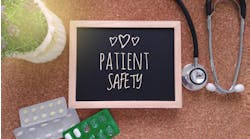Clinicians delivering care in the new COVID-19 shaped-landscape are needing more clinical and resource decision support than ever. This new environment is full of both opportunities and challenges for clinical IT leaders who are generating new learnings every day throughout this unprecedented health crisis.
At Franciscan Missionaries of Our Lady Health System (FMOLHS), a health system serving Louisiana and Mississippi, Stephen Hosea, M.D., the chief medical information officer (CMIO) at FMOLHS, says the organization’s clinical informatics journey has spanned across multiple phases “that all seem to have a life of their own.” He explains that the health system, like many others back in March, needed to rapidly mobilize their teams to do lots of build and support from a technical perspective so it could provide new tools , essentially overnight, in clinical areas to adequately address the needs of the moment.
In a recent interview with Healthcare Innovation, Hosea provided further details on the clinical IT challenges his team has faced during the pandemic, the most important lessons learned so far, and more. Below are excerpts of that discussion.
How has the clinical IT landscape in your organization changed in the face of COVID? In which ways are providers needing extra clinical and resource decision support?
We did a lot of work back in March reconfiguring our systems. Some of that is technical from an EHR standpoint, making sure we have the right codes and orderables, and clinical decision support within the system to make sure that if we did order a COVID test on a patient, everyone was aware this is a suspected patient, so let’s take the appropriate precautions. We were really taxed in the first few weeks, particularly when there were a lot of testing transitions occurring. Some other CMIOs called it the Wild West of COVID testing since every day seemed to be a little different [from the last]. We had to accommodate new testing and make sure we could make it as [seamless] as possible on physicians so that they could order the test and get results back on their patients without having to search and take unnecessary time figuring out what to do.
A lot of reporting needs came up early on, too, not only within the organization itself—so that we understood the state of our facilities in regards to bed access and ventilator access—but also enabling the ability to report to state agencies and other agencies that were rapidly ramping up requirements so that on a state and national level they could support regions as effectively as possible. And data is obviously a big piece of that.
Healthcare changed overnight; we went from traditional ways of providing care to quickly [turning] to telehealth because of restrictions [preventing] patients from coming into our facilities. Fortunately for us, we had already laid a lot of critical groundwork to allow and facilitate telehealth, but even with that, we had low volume of telehealth occurring in our communities at the beginning of March. So we quickly mobilized resources to operationally ramp up that service, which included a lot of training for staff and a lot of engagement with patients and communities. We also developed materials and marketed them so that patients had access to resources that [educated] them on how to schedule a telehealth appointment and how to engage on that appointment. And should they have problems, say from a technical standpoint, there were resources available to help them complete that interaction in an efficient manner.
What have been the core clinical IT challenges for your health system in this new environment?
I would draw a similarity to going to online schooling. When you [switch] to that overnight, you have these assumptions about the world, the community, what people have access to, and their competency with technology. And a lot of those presumptions are based on your daily life and the resources you have within your sphere. When all of a sudden you pivot from a 90:10 environment, where 90 percent of our encounters were face-to-face, to the exact opposite, you quickly realize that not all people have up-to-date smartphones or access to adequate Wi-Fi in their homes.
We’re a fairly rural state, so we also have some coverage challenges that have come up in certain areas. A lot of the challenges we came across have been [technological] ones that are sometimes hard to work through in the moment when you’re trying to complete a clinical encounter with the patient and you already have a lot going on. With our own technical setup, we have some really strong vendor partners, and we worked through a number of challenges that became more apparent because of the load being put on the system.
The telehealth experience is not only important to the patient—giving them a product and an experience that they feel good about and are easily able to slip into—but the same is equally important from the provider side. They also want something that is consistent, intuitive, and that doesn’t disrupt the relationship they have with the patient in that moment.
FMOLHS recently launched both a new find-a-provider experience and online appointment booking platform as part of your efforts to improve patient-provider matching and patient access. Can you describe this initiative and its importance in response to the crisis?
We have a lot of data on both our medical staff and employed physicians that has been in disparate systems. We also have credentialing software that has important information to make sure our medical staff is credentialed and has maintained credentialing, and that we can track the important aspects of their practice and their training. We have an EHR that also has a lot of information on [facility] location and availability, and we have another application that collects a lot of data on the ratings of our employed physicians. But we never had a data repository, per se, that brought all that together.
For patients who are consumers in the community looking for healthcare resources—just like if you were shopping for anything else—the expectation is that I want to see a picture of it, I want to have adequate information on it, I want to see reviews, and if I don’t have all that pulled together, I am unlikely to click purchase on that product. I’ll go look somewhere else where I can find a product that meets those needs and that has all the data points that are important to me.
Kyruus has been really helpful to bring all that together, and we had worked [together] for quite a few months leading up to our recent implementations. This gives consumers a much more robust dataset upon which they can make a decision, and gives them additional banners alerting them that if they have COVID symptoms, call us first. Don’t just book an appointment, because we’re working on processes to make sure that we’re providing safe care for both you and our staff. We’re also able to highlight the fact that we have telehealth available, which has been significant since there’s been plenty of community fear [about coming in for care]. So this made the consumers feel better since it presented a safer way to interact with providers, and we were able to market that ability and let patients know we have appointments available.
What have we learned about patient/consumer engagement during the pandemic that could be applied to the future?
One thing I have learned is that it’s a journey, and working on that experience and providing something better to the community is a very iterative process. It’s something we will need to continue to work on for the foreseeable future. As much as I’d like to predict what healthcare will look like five years from now, we don’t really know. The winners in this space will continue to look for opportunities to innovate, and provide a better and more effective experience that will ultimately be judged by the consumer.


